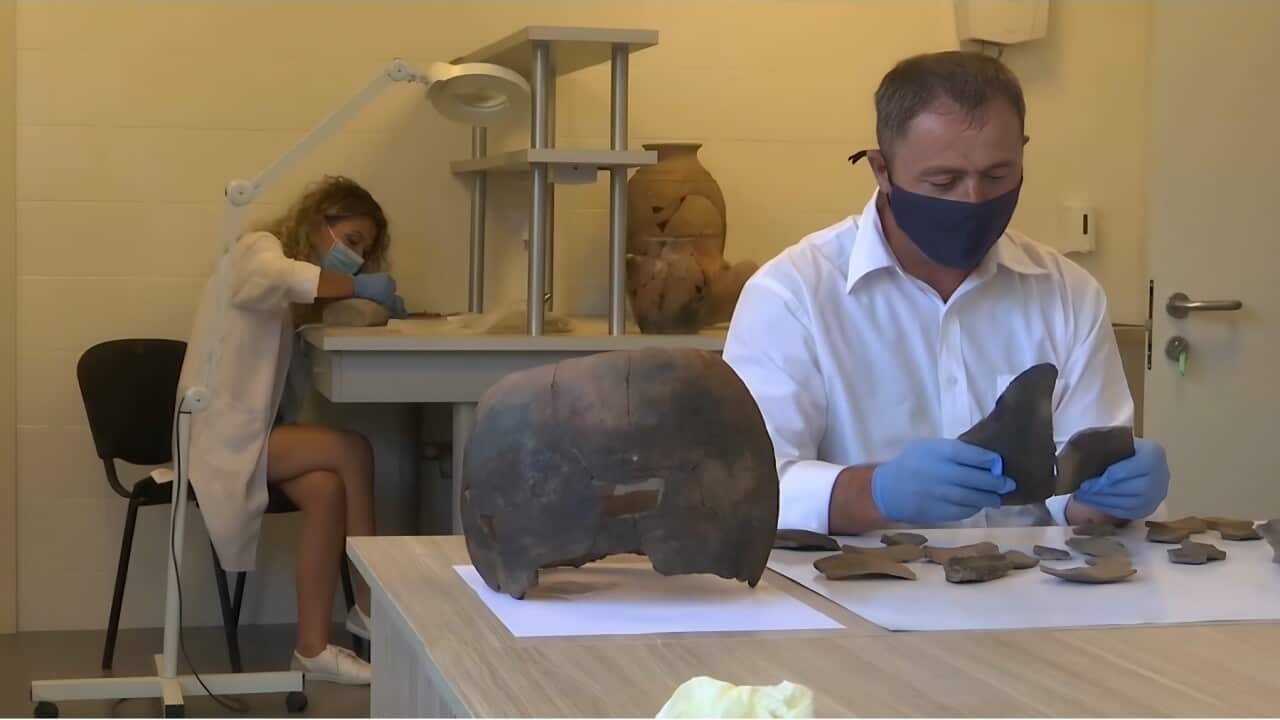TRANSCRIPT
A study which explores the evolutionary history of genetic disease has discovered multiple sclerosis evolved from genes which protected the Bronze Age Yamnaya nomadic herders from infections carried by their cattle and sheep.
The study published in Nature magazine compares modern D-N-A with ancient human D-N-A from teeth and bones, revealing insights into prehistoric migration and disease-linked genes.
Scientists collaborated with archaeologists and museums globally, using cutting-edge molecular biology techniques to extract and sequence ancient D-N-A.
Co-author Evan Irving-Pease is an Associate Professor in population genetics at the University of Copenhagen.
He explains the different genetics that came from three big waves of migration.
“There was the initial migration of humans out of Africa and ultimately into Europe, where modern humans replaced Neanderthals. And there was a second major migration at the beginning of a period we called the Neolithic or the new Stone age, which was with the invention of farming. So the earliest domestication of crops and and domestic animals, and that spread out of Anatolia in present day Turkey, and up through the Aegean and ultimately into north western Europe.”
The Yamnaya, nomadic herders came in a third migration into Europe.
“And there was a third later, a major migration at the beginning of the Bronze Age from peoples who, um, came from the Pontic steppe, a region that encompasses present day Ukraine and parts of southern Russia. And these people had a nomadic pastoralist lifestyle, and they came in at the beginning of the Bronze Age and largely replaced the Neolithic people that were practising farming at that time.”
Yamnaya people migrating to Europe in the Bronze Age carried gene variants increasing multiple sclerosis risk, possibly spreading them due to protective effects against infections from their livestock.
The ancient D-N-A provides insights into various diseases, according to Mr Irving-Pease.
“What we've been able to do in this study is looking at, um, genetic variants in present day people that encode risk for a range of different diseases, including autoimmune diseases like multiple sclerosis and rheumatoid arthritis, but also other diseases that have a large genetic component like Alzheimer's disease or type two diabetes. And we can trace these genetic variants backwards in time using these ancient genomes to understand how disease risk has evolved over time.”
Scientists are also learning more about the origins of dementia.
“We can show that the genetic variants that increase your chance of getting Alzheimer's disease or type two diabetes these came from the hunter gatherer people that first occupied Europe, whereas the farmer people who came in at the beginning of the Neolithic, around 10,000 years ago, um, there they carried um, genetic variants, um, associated with mood disorders. So anxiety, uh, and guilty feelings. Whereas the the final migration of people from the steppe, they brought with them genetic variants that increase our risk of autoimmune disease.”
DNA samples spanning millennia have revealed a link between multiple sclerosis (M-S) and ancient genes in northern Europeans.
M-S risk might be connected to zoonotic pathogens from close contact with Bronze Age animals, suggesting the ancient gene could protect against disease.
The study, led by Professor Lars Fugger, supports the theory that certain infections trigger M-S in genetically susceptible individuals, showcasing a survival of the fittest scenario.
“Given that they were living with the animals, given that they were drinking, eating milk meat from these animals that were not pasteurised, all of a sudden they would be exposed to a load of pathogens. And then by doing so, they would have people who would die or people who would survive, and those who would survive were, of course, those who had an immune system that could handle this new load of a pathogens here. So that is sort of its typical positive selection story. Survival of the fittest.”
The study has also demystified multiple sclerosis, revealing that the risk for northern Europeans is linked to an outdated gene protecting against ancient threats.
The trait now poses a problem due to an unbalanced immune system, requiring current treatment through immune system suppression.
“So when we are puzzled about why it's so difficult to treat my patients, why we have to use these broad immunosuppressive drugs, we need to bear in mind that what we are trying to fight is evolution. We are trying today with drugs to battle an immune system that has been selected for over a long period of time, and we are trying to do this in a very short period of time.”
The study's findings won’t impact the treatment of MS patients, Mr Fugger says that will take a long time.
He says the sheer number of genes involved makes the disease difficult to tackle.
“MS is a complex disease, meaning that we have 240 genes that confer risk to MS and it should be seen in the context of those genes interacting with different environments or factors. So therefore, the answer going forward will be to try to modify that healthy immune system. So sort of damp it a bit and that's why I keep on talking about the sweet spot. Find the sweet spot where the immune system is modified to an extent where you can reign disease without having the side effects being associated with the big immunosuppressive drugs.”
Researchers compared ancient DNA with 400,000 modern individuals in a UK gene bank, revealing MS-linked genetic variations in the north, aligning with the Yamnaya migration.
The findings explain the Europe MS divide, but confirmation is pending further research.













